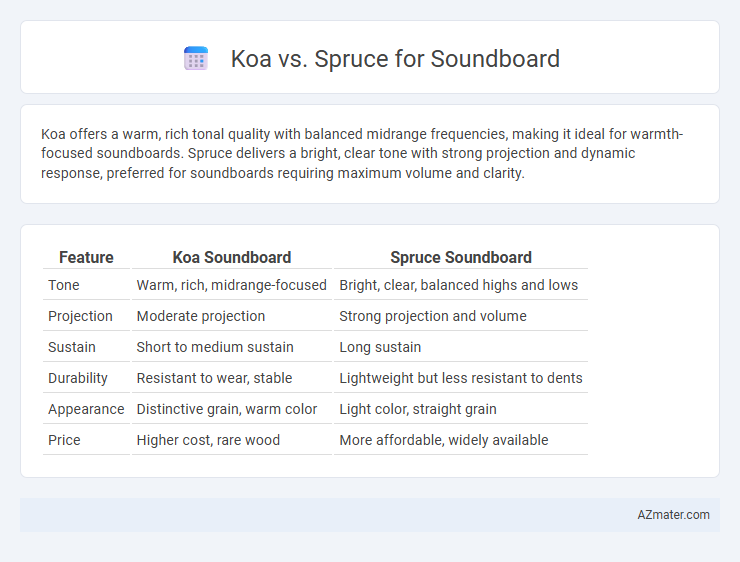Koa offers a warm, rich tonal quality with balanced midrange frequencies, making it ideal for warmth-focused soundboards. Spruce delivers a bright, clear tone with strong projection and dynamic response, preferred for soundboards requiring maximum volume and clarity.
Table of Comparison
| Feature | Koa Soundboard | Spruce Soundboard |
|---|---|---|
| Tone | Warm, rich, midrange-focused | Bright, clear, balanced highs and lows |
| Projection | Moderate projection | Strong projection and volume |
| Sustain | Short to medium sustain | Long sustain |
| Durability | Resistant to wear, stable | Lightweight but less resistant to dents |
| Appearance | Distinctive grain, warm color | Light color, straight grain |
| Price | Higher cost, rare wood | More affordable, widely available |
Introduction to Soundboard Woods
Koa and Spruce are prominent woods used in soundboard construction, each contributing distinct tonal qualities to musical instruments. Koa, native to Hawaii, is prized for its warm, midrange-focused sound and visually striking grain patterns, enhancing both acoustic warmth and aesthetic appeal. Spruce, particularly Sitka Spruce, is renowned for its strength-to-weight ratio and bright, clear tonal response, making it a preferred choice for vibrant projection and dynamic range in soundboards.
Overview of Koa Wood for Soundboards
Koa wood, native to Hawaii, is highly prized for soundboards due to its rich tonal qualities and balanced resonance. Its dense grain structure offers clarity and warmth, making it ideal for acoustic guitars and ukuleles. The wood's durability and natural beauty also contribute to its popularity among luthiers crafting premium soundboards.
Overview of Spruce Wood for Soundboards
Spruce wood is highly prized for soundboards due to its exceptional strength-to-weight ratio, which enhances acoustic resonance and projection in musical instruments. Its straight grain and uniform texture contribute to consistent vibration transmission, making it a preferred choice for pianos, guitars, and violins. Compared to koa, spruce offers superior tonal clarity and responsiveness, essential for achieving vibrant and dynamic sound quality in soundboards.
Tonal Characteristics: Koa vs Spruce
Koa wood offers a warm, bright tonal character with a balanced midrange and rich overtones, making it ideal for soundboards that emphasize clarity and warmth. Spruce is renowned for its dynamic range and responsiveness, delivering a bright, crisp sound with excellent projection and sustain. While Koa provides a more complex, sweet tone suitable for nuanced playing, Spruce excels in versatility and clarity, favored in many traditional and high-performance acoustic instruments.
Resonance and Projection Comparison
Koa offers superior resonance due to its dense grain structure, enhancing mid to high-frequency overtones crucial for clear soundboard projection. Spruce, known for its exceptional stiffness-to-weight ratio, provides a brighter and more immediate projection with a balanced tonal response across frequencies. Comparing soundboards, koa emphasizes warmth and sustain, while spruce excels in dynamic range and articulate note definition.
Durability and Longevity of Koa and Spruce
Koa wood offers superior durability and resistance to wear compared to spruce, making it an excellent choice for soundboards needing long-term resilience. Spruce is prized for its lightweight and rigidity, providing bright tonal qualities but generally exhibits less durability under heavy use. Over time, koa's dense grain structure contributes to enhanced longevity, maintaining structural integrity and sound quality in demanding environments.
Aesthetic Differences: Visual Appeal
Koa offers a warm, rich grain pattern that enhances the visual appeal of soundboards with natural, organic aesthetics favored by traditional luthiers. Spruce provides a lighter, more uniform appearance with a fine, straight grain that appeals to contemporary designs seeking a clean, bright look. The choice between Koa and Spruce greatly influences the instrument's visual character, balancing rustic charm against sleek sophistication.
Suitability for Different Musical Styles
Koa offers a warm, rich tone ideal for genres like jazz and blues, where complex harmonics and smooth sustain are essential. Spruce delivers a bright, clear sound with strong projection, making it well-suited for styles requiring articulate attack and dynamic range, such as folk and bluegrass. Selecting between Koa and Spruce depends on the desired tonal characteristics and the specific musical style to be performed.
Price and Availability of Koa vs Spruce
Koa wood is considerably more expensive than Spruce due to its rarity and limited supply, often costing two to three times more per board foot. Spruce is widely available and more affordable, commonly used in soundboard production because of its excellent tonal properties and steady supply. Choosing Spruce offers budget-friendly options without compromising sound quality, while Koa suits high-end, premium instruments seeking distinctive aesthetics and unique tonal warmth.
Choosing the Best Soundboard Wood for Your Needs
Selecting the best soundboard wood between Koa and Spruce depends on tonal preferences and application. Koa offers a warm, rich midrange and strong projection, making it ideal for Hawaiian and folk instruments that benefit from its unique harmonic complexity. Spruce, renowned for its bright, clear tone and excellent dynamic range, is preferred in many acoustic guitars and soundboards where responsiveness and versatility are critical.

Infographic: Koa vs Spruce for Soundboard
 azmater.com
azmater.com